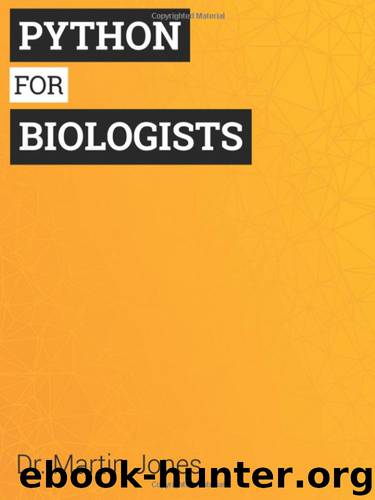Python for Biologists: A complete programming course for beginners by Dr Martin Jones

Author:Dr Martin Jones [Jones, Dr Martin]
Language: eng
Format: epub
Publisher: UNKNOWN
Published: 2018-06-12T23:00:00+00:00
We'll get an error: NameError: name 'a_count' is not defined 1 Indeed, it doesn't actually exist when it's defined, only when it runs.
Calling and improving our function
Let's write a small program that uses our new function, to see how it works. We'll try both storing the result in a variable before printing it (lines 8 and 9) and printing it directly (lines 10 and 11):
1 def get_at_content(dna):
2 length = len(dna)
3 a_count = dna.count('A')
4 t_count = dna.count('T')
5 at_content = (a_count + t_count) / length
6 return at_content
7
8 my_at_content = get_at_content("ATGCGCGATCGATCGAATCG")
9 print(str(my_at_content))
10 print(get_at_content("ATGCATGCAACTGTAGC"))
11 print(get_at_content("aactgtagctagctagcagcgta"))
Looking at the output, we can see that the first function call works fine – the AT content is calculated to be 0.45, is stored in the variable my_at_content, then printed. However, the output for the next two calls is not so great. The call at line 10 produces a number with way too many figures after the decimal point, and the call at line 11, with the input sequence in lower case, gives a result of 0.0, which is definitely not correct:
0.45
0.5294117647058824
0.0
We'll fix these problems by making a couple of changes to the get_at_content function. We can add a rounding step in order to limit the number of significant figures in the result. Python has a built-inround function that takes two arguments – the number we want to round, and the number of significant figures. We'll call theround function on the result before we return it. And we can fix the lower case problem by converting the input sequence to upper case before starting the calculation. Here's the new version of the function, with the same three function calls:
def get_at_content(dna):
length = len(dna)
a_count = dna.upper().count('A') t_count = dna.upper().count('T') at_content = (a_count + t_count) / length return round(at_content, 2)
my_at_content = get_at_content("ATGCGCGATCGATCGAATCG") print(str(my_at_content))
print(get_at_content("ATGCATGCAACTGTAGC"))
print(get_at_content("aactgtagctagctagcagcgta"))
Download
This site does not store any files on its server. We only index and link to content provided by other sites. Please contact the content providers to delete copyright contents if any and email us, we'll remove relevant links or contents immediately.
Hello! Python by Anthony Briggs(10120)
The Mikado Method by Ola Ellnestam Daniel Brolund(10011)
OCA Java SE 8 Programmer I Certification Guide by Mala Gupta(9980)
Algorithms of the Intelligent Web by Haralambos Marmanis;Dmitry Babenko(8522)
Sass and Compass in Action by Wynn Netherland Nathan Weizenbaum Chris Eppstein Brandon Mathis(7915)
Grails in Action by Glen Smith Peter Ledbrook(7881)
Test-Driven iOS Development with Swift 4 by Dominik Hauser(7853)
The Well-Grounded Java Developer by Benjamin J. Evans Martijn Verburg(7770)
Windows APT Warfare by Sheng-Hao Ma(7462)
Layered Design for Ruby on Rails Applications by Vladimir Dementyev(7213)
Blueprints Visual Scripting for Unreal Engine 5 - Third Edition by Marcos Romero & Brenden Sewell(7097)
Secrets of the JavaScript Ninja by John Resig Bear Bibeault(6634)
Kotlin in Action by Dmitry Jemerov(5297)
Hands-On Full-Stack Web Development with GraphQL and React by Sebastian Grebe(4382)
Solidity Programming Essentials by Ritesh Modi(4365)
WordPress Plugin Development Cookbook by Yannick Lefebvre(4179)
Functional Programming in JavaScript by Mantyla Dan(4124)
Unity 3D Game Development by Anthony Davis & Travis Baptiste & Russell Craig & Ryan Stunkel(4095)
The Ultimate iOS Interview Playbook by Avi Tsadok(4063)
